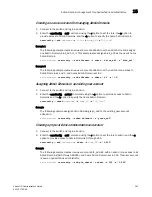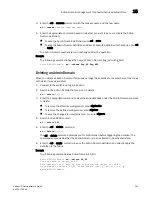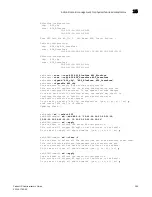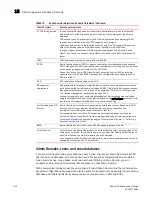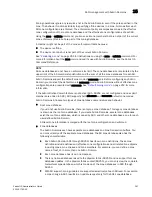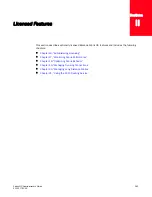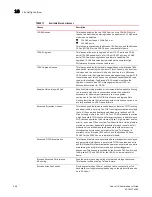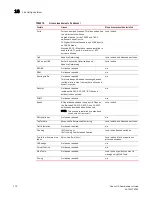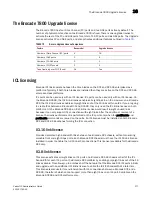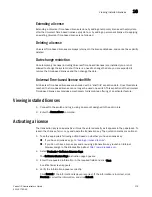
360
Fabric OS Administrator’s Guide
53-1001763-02
SAN management with Admin Domains
15
Admin Domains, zones, and zone databases
If you are working with zones, you should be aware of how they impact Admin Domains. Each AD
has its own zone database, with both defined and effective zone configurations and all related
zone objects (zones, zone aliases, and zone members). Within an Admin Domain, you can
configure zoning only with the devices that are present in that Admin Domain.
With a hierarchical zoning model, the name space for each Admin Domain and the root zones are
separate; configurations are supported with the same zone object name appearing in the root zone
database and different ADs (for example, the same zoneset name in AD1 and AD2).
FC-FC Routing Service
You can create LSAN zones as a physical fabric administrator or as an individual AD
administrator. The LSAN zone can be part of the root zone database or the AD zone
database.
FCR collects the LSAN zones from all ADs. If both edge fabrics have matching LSAN
zones and both devices are online, FCR triggers a device import.
LSAN zone enforcement in the local fabric occurs only if the AD member list contains
both of the devices (local and imported device) specified in the LSAN zone.
To support legacy applications, WWNs are reported based on the AD context using
NAA=5. As a result, you cannot use the NAA=5 field alone in the WWN to detect an FC
router.
FDMI
FDMI operations are allowed only in AD0 and AD255.
FICON
Admin Domains support FICON. However, you must perform additional steps because
FICON management (CUP) requires additional physical control of the ports. You must set
up the switch as a physical member of the FICON AD.
Device Connection Control (DCC) and Switch Connection Control (SCC) policies are
supported only in AD0 and AD255, because ACL configurations are supported only in
AD0 and AD255.
iSCSI
iSCSI operations are supported only in AD0.
Management
applications
Management interfaces that access the fabric without a user’s credentials continue to
get the physical fabric view. Examples include SNMPV1, Web Tools, http access, unzoned
management server query, FAL in-band CT requests from FAL Proxy to FAL Target, and
FC-CT based management applications (such as Tivoli).
Access from applications or hosts using Management Server calls can be controlled
using the Management Server ACL support provided by the msConfigure command. Note
that this is a switch-specific setting and not a fabric-wide setting.
Port-Swapping and PID
formats
Admin Domain port members are specified in
domain,index
format. Based on the PID
format, a
domain,index
member indicates a slot and port in the switch. The
domain,index
member is effectively a member of that AD.
Port swapping has no effect on AD support as port swapping swaps only the area
numbers of two ports and Admin Domains are specified using
domain,index
members.
For detailed information about configuring the PID format, see
Chapter 3, “Performing
Advanced Configuration Tasks”
.
RSCN
Admin Domains do not introduce any RSCN changes to devices or hosts.
Virtual Fabrics
Virtual Fabrics and Admin Domains are mutually exclusive and are not supported at the
same time on a switch. To use Admin Domains, you must first disable Virtual Fabrics; to
use Virtual Fabrics, you must first delete all Admin Domains.
If you connect a switch with Admin Domains to a Virtual Fabric-enabled switch, the link is
segmented with the reason “VF AD conflict.”
TABLE 75
Admin Domain interaction with Fabric OS features (Continued)
Fabric OS feature
Admin Domain interaction
Содержание 53-1001763-02
Страница 1: ...53 1001763 02 13 September 2010 Fabric OS Administrator s Guide Supporting Fabric OS v6 4 0 ...
Страница 4: ...iv Fabric OS Administrator s Guide 53 1001763 02 ...
Страница 24: ...xxiv Fabric OS Administrator s Guide 53 1001763 02 ...
Страница 28: ...xxviii Fabric OS Administrator s Guide 53 1001763 02 ...
Страница 32: ...xxxii Fabric OS Administrator s Guide 53 1001763 02 ...
Страница 40: ...xl Fabric OS Administrator s Guide 53 1001763 02 ...
Страница 42: ...2 Fabric OS Administrator s Guide 53 1001763 02 ...
Страница 54: ...14 Fabric OS Administrator s Guide 53 1001763 02 High availability of daemon processes 1 ...
Страница 74: ...34 Fabric OS Administrator s Guide 53 1001763 02 Basic connections 2 ...
Страница 102: ...62 Fabric OS Administrator s Guide 53 1001763 02 Audit log configuration 3 ...
Страница 156: ...116 Fabric OS Administrator s Guide 53 1001763 02 The authentication model using RADIUS and LDAP 5 ...
Страница 214: ...174 Fabric OS Administrator s Guide 53 1001763 02 Management interface security 7 ...
Страница 228: ...188 Fabric OS Administrator s Guide 53 1001763 02 Brocade configuration form 8 ...
Страница 276: ...236 Fabric OS Administrator s Guide 53 1001763 02 Creating a logical fabric using XISLs 10 ...
Страница 404: ...364 Fabric OS Administrator s Guide 53 1001763 02 ...
Страница 440: ...400 Fabric OS Administrator s Guide 53 1001763 02 Performance data collection 17 ...
Страница 464: ...424 Fabric OS Administrator s Guide 53 1001763 02 Disabling bottleneck detection on a switch 18 ...
Страница 480: ...440 Fabric OS Administrator s Guide 53 1001763 02 F_Port masterless trunking 19 ...
Страница 494: ...454 Fabric OS Administrator s Guide 53 1001763 02 Buffer credit recovery 20 ...
Страница 560: ...520 Fabric OS Administrator s Guide 53 1001763 02 Port indexing on the Brocade DCX 4S backbone C ...
Страница 574: ...534 Fabric OS Administrator s Guide 53 1001763 02 Hexadecimal overview E ...


